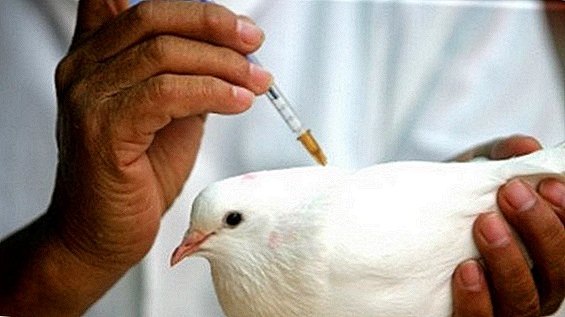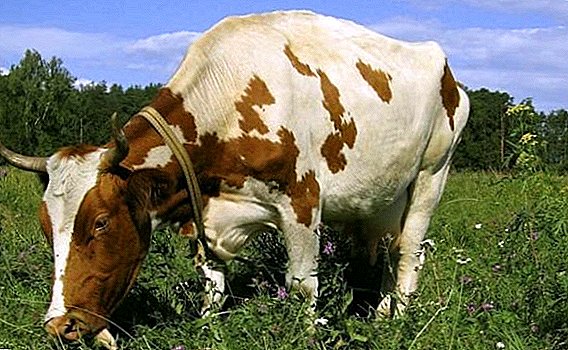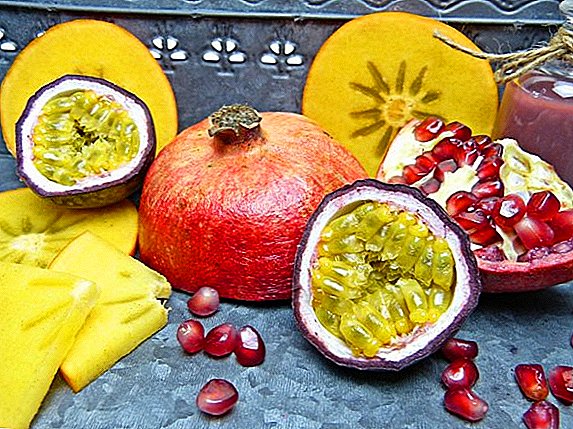
The chicken beak is not only a means for getting food and cleaning feathers. Often it becomes a rather dangerous weapon for especially aggressive birds.
They begin to peck other chickens, causing them unpleasant injuries that can cause the development of dangerous diseases.
Almost all domestic chickens can be observed cannibalism or peck. However, it is most often observed in young animals, and not in healthy individuals.
What is cannibalism in chickens?
The peck is that some chickens start pecking at the back of the body around the cloaca of their brethren. They peck other chicks so hard that they have a cloaca bleeding. Sometimes these chicks are so aggressive that they can peck the back of the intestines.
The clinical picture of cannibalism is very unpleasant for the human eye: the chicken victim is lying on its side, and the more aggressive get together bravely peck at it. Some other chicks start feeding on fallen kin., and this is fraught with the spread of cannibalism among other individuals. In addition, the entire population of chickens increases the risk of catching an unpleasant infectious disease.
Degree of danger
 Rasklev among young stock is quite common. Almost every bird breeder faces such a problem at the beginning of breeding chickens, therefore it is difficult to determine exactly when this problem first manifested itself.
Rasklev among young stock is quite common. Almost every bird breeder faces such a problem at the beginning of breeding chickens, therefore it is difficult to determine exactly when this problem first manifested itself.
Cannibalism carries a special large number of hazards for the entire livestock of poultry on the farm. The fact is that the wounds that remain after the bite are the ideal habitat for pathogens. Subsequently, they can cause a particular infectious disease, and it, in turn, can destroy all birds, even adults, if they are not well isolated.
Causes of disease
 Unfortunately, the exact reasons for the slander have not been clarified so far. Veterinarians believe that one of the most likely causes is a gross violation of the conditions in which the young are kept. First, it can affect too high landing density (for example, 10% higher than normal). Youngsters do not have enough free space, so some individuals begin to negatively relate to their neighbors, as a rule, weaker ones.
Unfortunately, the exact reasons for the slander have not been clarified so far. Veterinarians believe that one of the most likely causes is a gross violation of the conditions in which the young are kept. First, it can affect too high landing density (for example, 10% higher than normal). Youngsters do not have enough free space, so some individuals begin to negatively relate to their neighbors, as a rule, weaker ones.
Secondly, the risk of slander increases if there are any mechanical damages on the chicks. Wounded birds immediately stand out against the background of healthy and strong young animals, so they start to take advantage of the moment attacking them. Also, the distribution of various parasites, which are dangerous not only because of the possible manifestation of cannibalism, can play a role. They can cause one of the infectious diseases.
Pecking among chickens may occur due to the abrupt change of diet and low humidity. Often such cases are found in inexperienced breeders. At the beginning of poultry breeding, they try to buy expensive feed, but then the funds run out, and the chickens have to be transferred to a more economical diet. Subsequently, this negatively affects their behavior.
Especially bad for young birds affected by improper feeding. Unbalanced nutrition, the presence of parasites in the diet, the imbalance of valuable amino acids, the presence of microtoxins, lack of vitamins and trace elements - all this can be the first and main cause of cannibalism. Chickens are trying to fill the lack of useful elements in the body, killing their relatives.
Most veterinarians believe that the most common cause of cannibalism is protein deficiency in feed. This mainly applies to Brahma chickens and broilers, who need large amounts of protein in order to gain muscle mass quickly.
Course and symptoms
 Reflex of pecking can be manifested among chickens of any age. As a rule, it appears immediately after the change of soft embryonic down to the first plumage. At this point, the chickens are most acutely aware of the lack of beneficial trace elements, so they gradually begin to pick up the fallen feathers.
Reflex of pecking can be manifested among chickens of any age. As a rule, it appears immediately after the change of soft embryonic down to the first plumage. At this point, the chickens are most acutely aware of the lack of beneficial trace elements, so they gradually begin to pick up the fallen feathers.
As soon as the farmer begins to notice this behavior of the chickens' environment, measures must be taken immediately, otherwise pecking may begin soon.
Chickens predisposed to cannibalism can be identified by nervousness. Their movements become sharper.
The most aggressive individuals begin to attack the weakest chickens., and soon - to all who are near. Gradually, the desire to peck other birds becomes a habit, and then develops into a conditioned reflex.
Diagnostics
Even an inexperienced breeder of chickens can identify pecking or cannibalism by the behavior of chickens. They begin to pluck feathers and peck at each other, leaving small wounds.
When such behavior is detected, measures must be taken immediately, otherwise the young growth may die.
Treatment
 Unfortunately, treatment is ineffective at almost all stages of the disease. Aggressive chickens are very difficult to wean off pecking their fellows, if they are already used to doing it. However, such individuals can be quickly identified from the general herd. This allows farmers to isolate them from weaker and loving chickens.
Unfortunately, treatment is ineffective at almost all stages of the disease. Aggressive chickens are very difficult to wean off pecking their fellows, if they are already used to doing it. However, such individuals can be quickly identified from the general herd. This allows farmers to isolate them from weaker and loving chickens.
Some vets believe that stop cases of biting can be using saltwhich is added to the feed. You can also use feed with a high content of meal, meal and oats. This may help aggressive chickens to restore the balance of trace elements, but until it is fully restored, weaker birds may be injured. That is why during this period you need to seriously monitor all the young.
As for the affected chickens, their wounds need to be treated every day with an antiseptic solution. This will contribute to the rapid healing of biting places, as well as help prevent the development of infection in the wound.
Prevention of slander in laying hens
Beak trimming
 One of the most effective methods of prevention is debrirovanie - pruning beak. At the same time, the tips of the upper and lower parts of the beak are completely removed from the bird. Thus, it is possible to prevent not only pecking, but also plucking feathers from chickens during stress.
One of the most effective methods of prevention is debrirovanie - pruning beak. At the same time, the tips of the upper and lower parts of the beak are completely removed from the bird. Thus, it is possible to prevent not only pecking, but also plucking feathers from chickens during stress.
Beak trimming should be done at an early age.so that the chickens cannot damage each other even during the first weeks of life. This procedure is carried out using hot blades. They do not hurt the bird, so this method of cutting is used on many chicken farms.
Another way to trim the beak is the infrared method. It is used exclusively in day-breeding chickens. Infrared light is directed to the bird's beak. It has a negative effect on the tip of the beak, so it gradually disappears by itself, without hurting the bird.
Genetic selection
Each breed of chickens has its own predisposition to chuck and cannibalism. As a rule, this applies to long chickens, which are characterized by high mortality among the young. This fact must be taken into account while keeping the bird, because the young of some breeds will not be able to survive without a trimmed beak.
Now modern breeders continue to work on the breeding of non-aggressive breeds of chickens, which in the future will not require surgical pruning of the beak. This will help relieve the bird from stress and possible complications.
Proper nutrition
 Unbalanced diet is one of the most common causes of snapping among chickens. That is why the farmer needs to create the right "menu" for his chickens. Firstly need to monitor protein content in feed.
Unbalanced diet is one of the most common causes of snapping among chickens. That is why the farmer needs to create the right "menu" for his chickens. Firstly need to monitor protein content in feed.
You can also add a certain amount of poorly digestible fiber: rice, wheat and oat bran. It has long been proven that fiber can soothe even the most aggressive chickens.
Another way to prevent biting is to feed the shredded grain. If the birds still peck, on the cages you can hang vegetable tops, on which the birds will disrupt their aggression.
Light mode
All chickens have color vision, so they respond well to changes in light. Green and blue color significantly accelerate growth, but at the same time puberty slows down. Red, yellow and orange, on the contrary, cause more rapid ripening, and also increase egg production in laying hens.
To prevent all cases of pecking, chickens should be raised in blue or dim white light. Under one of the versions, such a light calms the bird, and on the other, in such a light, the birds do not see each other well enough to start a fight.
 Phoenix chickens are famous all over the world for their ornamental tail, which can reach several meters.
Phoenix chickens are famous all over the world for their ornamental tail, which can reach several meters.To find out how to treat salpingitis in birds, read this article.
Using abrasives for beak
Some breeders add abrasives to poultry feed to help grind off their beaks. After a certain period of time, the beak becomes more obtuse from the end, so with its help it is difficult to peck another chicken. If the birds will constantly receive such food, the risk of biting will be close to zero.
Free Range Poultry
Each chicken coop should have a small walking area where chickens can easily spread their wings, run and look for food in the ground. This will distract them from the desire to peck their relatives, and also give a large area for movement.
Conclusion
Pecking in poultry is a very unpleasant phenomenon, which is fraught with dire consequences for the entire herd. To completely avoid this behavior disorder, it is sufficient to properly maintain the young and to monitor the behavior of the most active individuals.












